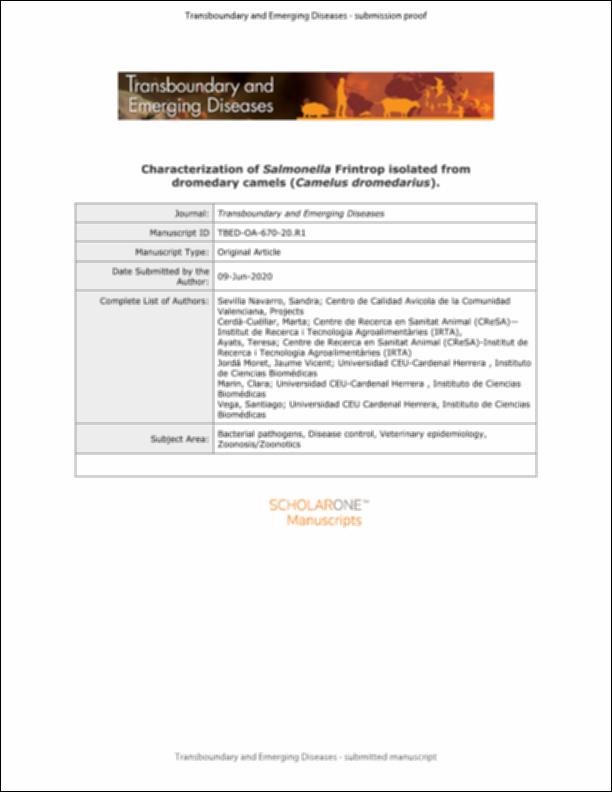Please use this identifier to cite or link to this item:
http://hdl.handle.net/10637/13871Characterization of "Salmonella Frintrop" isolated from dromedary camels (Camelus dromedarius)
| Title: | Characterization of "Salmonella Frintrop" isolated from dromedary camels (Camelus dromedarius) |
| Authors : | Sevilla Navarro, Sandra Cerdà Cuéllar, Marta Ayats, Teresa Jordá Moret, Jaume Vicent Marín Orenga, Clara Vega García, Santiago |
| Keywords: | Vibriosis.; Bacteriología veterinaria.; Veterinary bacteriology.; Pathogenic bacteria.; Resistencia a los medicamentos.; Salmonellosis in animals.; Camels - Communicable diseases.; Bacterias patógenas.; Drug resistance in microorganisms.; Salmonelosis en los animales.; Dromedarios - Enfermedades infecciosas. |
| Publisher: | John Wiley & Sons |
| Citation: | Sevilla-Navarro, S., Cerdà-Cuéllar, M., Ayats, T., Jordá, J., Marin, C. & Vega, S. (2021). Characterization of "Salmonella Frintrop" isolated from dromedary camels (Camelus dromedarius). Transboundary and Emerging Diseases, vol. 68, n. 2, pp. 742–746. DOI: https://doi.org/10.1111/tbed.13737 |
| Abstract: | Different studies have reported the prevalence and antibiotic resistance of Salmonella in dromedaries’ camels and its role in camelid-associated salmonellosis in humans, but little is known about the epidemiology of Campylobacter in dromedaries. Here we investigate the prevalence, genetic diversity and antibiotic resistance of Campylobacter and Salmonella in dromedary camels (Camelus dromedarius). A total of 54 individuals were sampled from two unique dromedary farms located in Tenerife (Canary Islands, Spain). Whilst all the samples were Campylobacter-negative, Salmonella prevalence was 5.5% (3/54) and the only serovar isolated was S. Frintrop. The pulsed field gel electrophoresis analysis revealed a low genetic diversity, with all isolates showing a nearly identical pulsotype (similarity > 95%). Our results indicate that dromedaries’ camels could not be a risk factor for Campylobacter human infection, but seems to be a reservoir for Salmonella transmission. Since camel ride has become one of the main touristic attractions in several countries and its popularity has considerably risen in the last years, a mandatory control, especially for zoonotic pathogens, such as Campylobacter and Salmonella should be implemented. |
| Description: | Este artículo se encuentra disponible en la siguiente URL: https://onlinelibrary.wiley.com/doi/epdf/10.1111/tbed.13737 En este artículo de investigación también participan: Marta Cerdà Cuéllar, Teresa Ayats, Jaume Jordá, Clara Marín y Santiago Vega. This is the pre-peer reviewed version of the following article: Sevilla-Navarro, S., Cerdà-Cuéllar, M., Ayats, T., Jordá, J., Marin, C., & Vega, S. (2021). Characterization of "Salmonella Frintrop" isolated from dromedary camels (Camelus dromedarius). Transboundary and Emerging Diseases, vol. 68, i. 2 (mar.), pp. 742?746, which has been published in final form at https://doi.org/10.1111/tbed.13737. This article may be used for non-commercial purposes in accordance with Wiley Terms and Conditions for Use of Self-Archived Versions. Este es el pre-print del siguiente artículo: Sevilla-Navarro, S., Cerdà-Cuéllar, M., Ayats, T., Jordá, J., Marin, C., & Vega, S. (2021). Characterization of "Salmonella Frintrop" isolated from dromedary camels (Camelus dromedarius). Transboundary and Emerging Diseases, vol. 68, i. 2 (mar.), pp. 742?746, que se ha publicado de forma definitiva en https://doi.org/10.1111/tbed.13737. |
| URI: | http://hdl.handle.net/10637/13871 |
| Rights : | http://creativecommons.org/licenses/by-nc-nd/4.0/deed.es |
| ISSN: | 1865-1674 1865-1682 (Electrónico) |
| Issue Date: | 10-Sep-2022 |
| Center : | Universidad Cardenal Herrera-CEU |
| Appears in Collections: | Dpto. Producción y Sanidad Animal, Salud Pública Veterinaria y Ciencia y Tecnología de los Alimentos |
Items in DSpace are protected by copyright, with all rights reserved, unless otherwise indicated.


